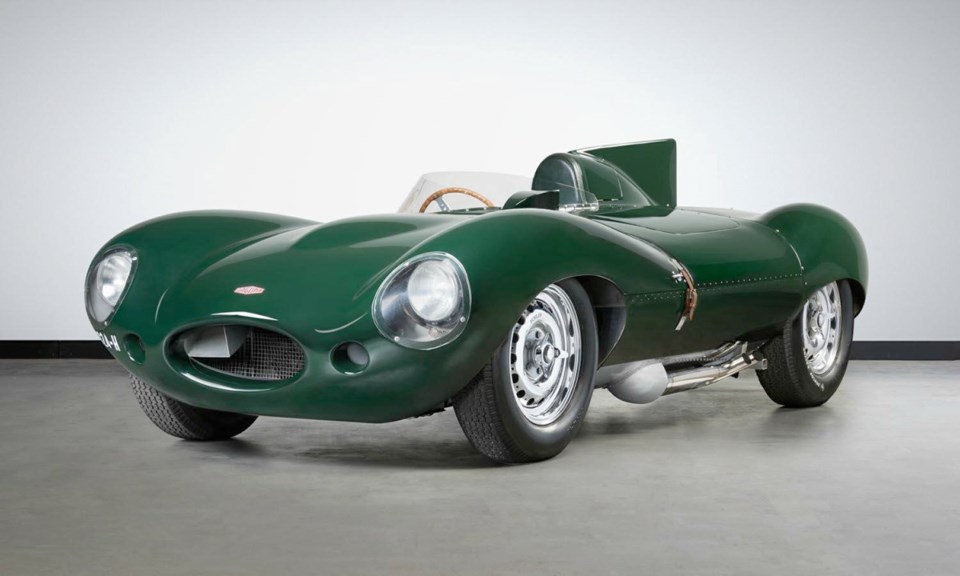When two young Blackpool motorcycle enthusiasts, William Lyons and William Walmsley, established the Swallow Sidecar Co. in 1922 to build zeppelin-shaped, aluminum-clad motorcycle sidecars, they didn’t know they were laying the foundation for a famous English marque.
They advanced to customizing Austin Sevens and others, and relocated to Coventry in 1928, renamed the Swallow Coachbuilding Co. They were soon building whole cars called SSs using Standard Motor Co. chassis and engines. They launched their famous Jaguar name in 1935.
Following the Second World War, the SS name had become toxic, so the company became Jaguar Cars Ltd. Jaguar continued building pre-war designs while developing new models, the first being the XK120 Roadster, introduced in 1948.
The XK120 had stunning appearance and performance, and while intended for touring, not racing, it was soon being campaigned. The factory even entered a three-car team in the 1950 Le Mans 24-hour race.
Although not expecting to win, the cars demonstrated enough potential to convince Jaguar to develop a competition model. This resulting C-Type was an attempt to return Britain to its Le Mans glory days of Bentley’s five wins in the 1920s.
The C-Type, with styling by aerodynamicist Malcom Sayer, fulfilled Jaguar’s hopes by winning Le Mans in 1951. It returned in 1952 with a new long, aerodynamic nose and smaller air intake. Unfortunately, insufficient air entered, causing overheating that forced the entire factory team to retire early. First and second places went to the sensational new Mercedes-Benz 300SL coupes.
Jaguar brought the regular-nosed C-Types back for 1953 with a new secret weapon: disc brakes, which allowed drivers to go deeper into corners before braking. It was the decisive factor and Jaguars finished first, second and fourth.
In spite of the C-Type’s success, competition from others such as Ferrari, Cunningham and Aston Martin was getting stronger, and Jaguar knew it would need a new design to remain competitive.
The result was the 1954 D-Type. Unlike the C-Type with its multiple steel-tube space-frame, the smaller D-Type had a monocoque body in which the light alloy skin panels contributed to overall stiffness. A square-tube aluminum space frame carried the engine, front suspension and rack-and-pinion steering, and a rear one supported the spare tire and fuel tank.
Power came from the XK120’s sturdy double-overhead-cam 3.4-litre inline six, with horsepower increased to 245 from the XK 120’s 160; it would ultimately reach over 300. For a lower profile, the engine had dry sump lubrication and was tilted eight degrees to the right. It drove through a new four-speed, all-synchromesh manual transmission.
In spite of only three months’ development time for the 1954 Le Mans race, the D-Type came in second between the winning 5.0-litre Ferrari V-12 and the third-place 5.5-litre Cunningham V-8.
Then began the D-Type’s Le Mans glory years. With a 190-millimetre longer, more aerodynamic nose, it finished first and third in 1955, first in 1956 and first, second and third in 1957.
The factory dropped out of racing in 1956, but the Scottish Ecurie Ecosse team continued racing the D-Types. It would score many more victories both in Europe and America, but its pinnacle was Le Mans, the race for which it was designed.
How fast was the D-Type? During the 1954 Le Mans race, Stirling Moss reached 278 km/h on the long Mulsanne straight. On regular roads, Road & Track reported zero to 100 km/h in 4.7 seconds and zero to 160 km/h in 12.1 seconds. They recorded a top speed of 261 km/h in the California desert, remarkably good performance even today.
With its three consecutive Le Mans wins, the Jaguar D-Type gave Britain its finest hours in international sports-car competition. A truly iconic car, it was also the inspiration for the beautiful Jaguar E-Type production car.
Jaguar Land Rover is now owned by India’s Tata Motors.



